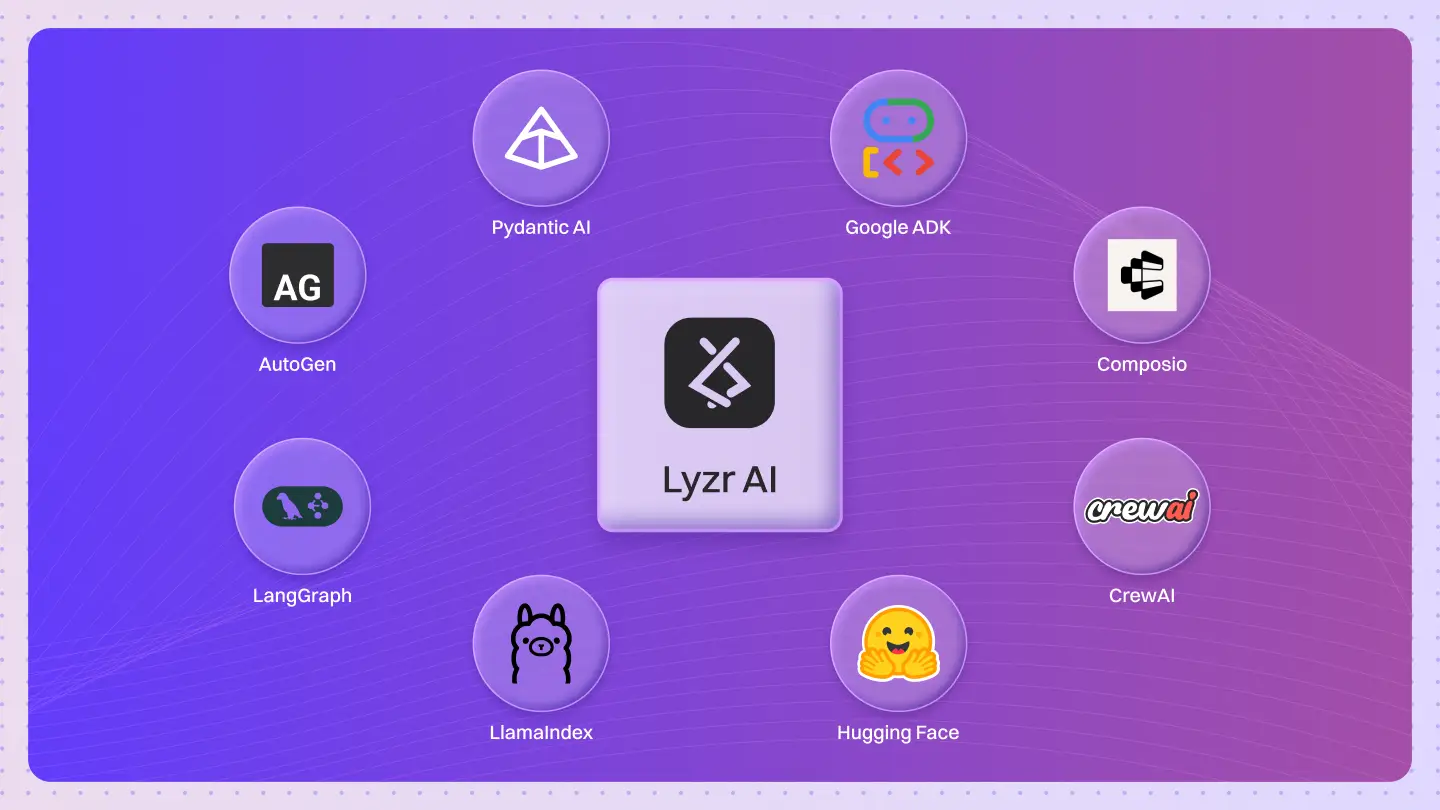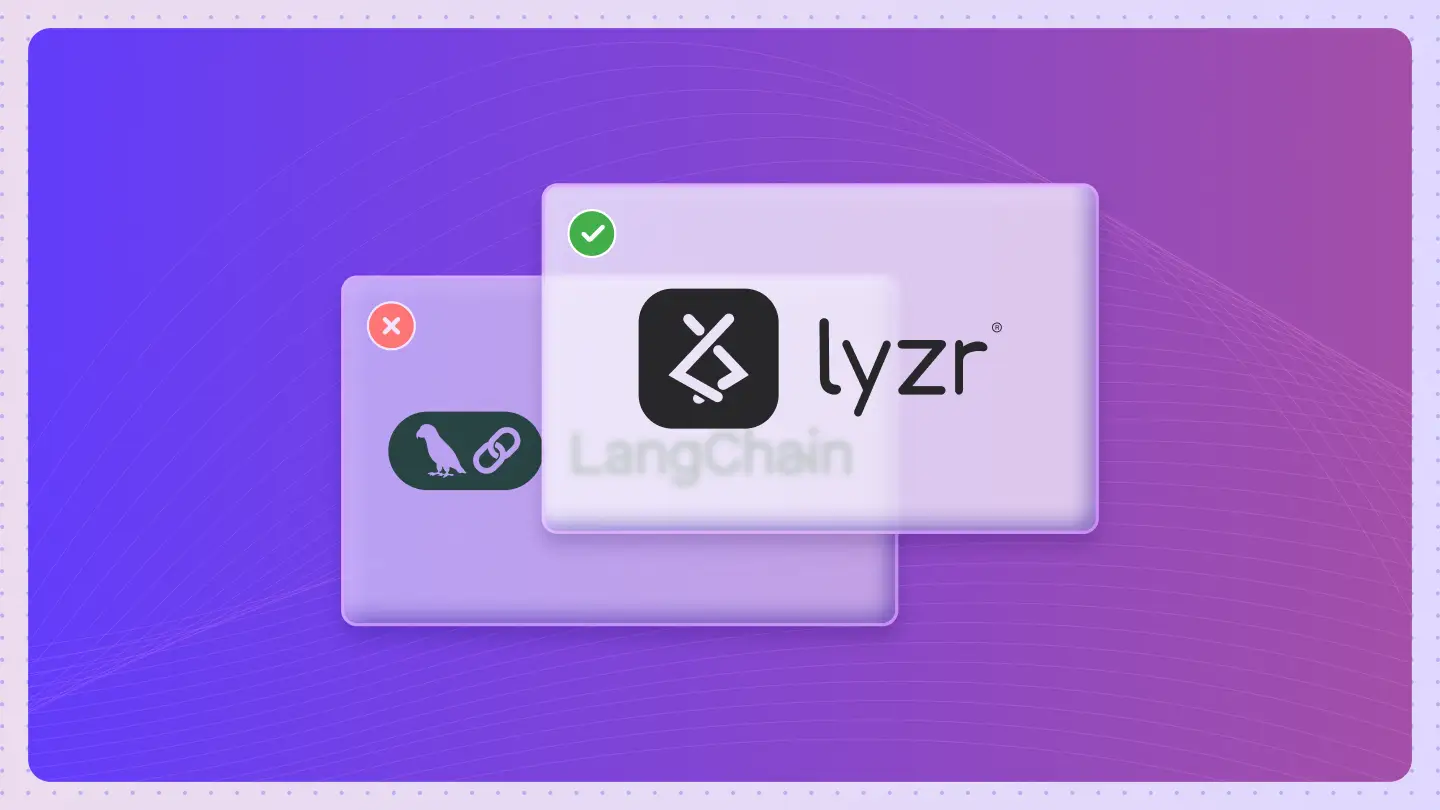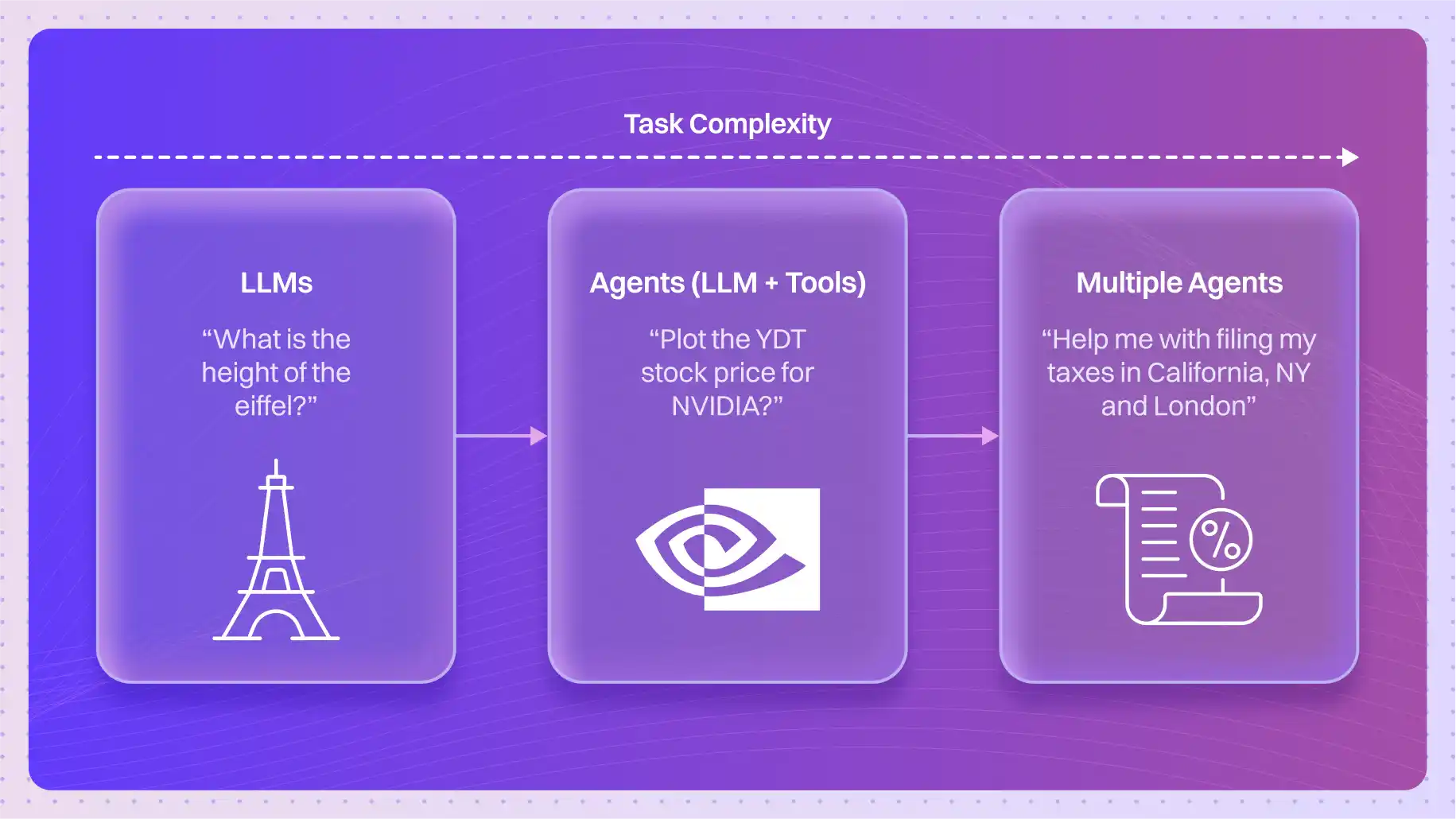Table of Contents
ToggleIf you’re evaluating top open source agentic frameworks like CrewAI, AutoGen, LangGraph, LangChain, or any other open-source agentic toolkit, you’re likely trying to answer one question:
“Which framework should we use to actually build and scale our agents?”
This guide gives you a clear, executive-friendly breakdown of:
- What each major open-source agentic framework is best suited for
- Their architectural philosophy
- Strengths, limitations, and ideal use cases
- The hidden operational costs teams discover only after the prototype
- How companies bridge the gap from experiments → production with orchestration platforms like Lyzr
Here’s the part most teams miss:
Open-source agentic frameworks are fantastic for prototyping but they don’t solve reliability, governance, or production deployment.
So in this guide, we’ll do two things:
1. Give you an honest, developer-informed comparison of the top open-source agentic frameworks.
No hype. No fluff. Just what actually matters.
2. Show you why production-grade agent systems require an orchestration layer and how companies pair open-source frameworks with platforms like Lyzr to achieve scale, compliance, and predictable ROI.
By the end, you’ll know:
✔ Which open-source framework fits your specific use case
✔ Where each one breaks down in real-world environments
✔ What infrastructure is needed to take multi-agent systems from demo enterprise-ready
How to Choose the Best Open Source Agentic Framework in 2025
Most teams start evaluating open-source agentic frameworks with the same goals:
- “Which framework is best for building real agents?”
- “Which one scales beyond demos?”
- “What are the trade-offs?”
But the problem is this:
Every framework looks incredible in a demo, and all of them claim to support multi-agent workflows.
In reality, each one solves a different problem:
- Some are built for quick prototypes
- Some for complex orchestration
- Some for RAG-heavy assistants
- Some for autonomous multi-agent loops
- Some are not truly “agentic” at all
So before you pick, you need clarity on:
✔ What you want to build
(Autonomous agents? Workflow automation? Customer-facing assistants?)
✔ How critical reliability and governance are
(Internal experiment vs customer-facing? Regulated data?)
✔ The engineering effort you can commit
(Some frameworks need heavy glue-code and infra setup.)
Only when your goals are clear does the comparison actually help.
Each of the top open source agentic frameworks offers a unique philosophy for agent interaction. Understanding these differences is crucial for selecting the right “engine” for your specific problem.
| Framework | Best For | Pros | Cons | Ideal Users |
| CrewAI | Multi-agent teamwork | Easy to start, fast prototyping | Not production-ready, unstable loops | Experimenters & early builders |
| AutoGen | Autonomous reasoning agents | Powerful autonomy, flexible patterns | Harder to control, more hallucinations | Advanced developers |
| LangGraph | Structured, stateful workflows | Strong orchestration, deterministic flows | Heavy engineering, missing enterprise controls | Teams with strong infra |
| LangChain | RAG + tools | Huge ecosystem, reliable connectors | Weak agent capabilities, lots of glue code | Teams building assistants/search |
| Haystack | Enterprise search/RAG | Solid search, good evaluation | Not agentic, no autonomy | Document-heavy orgs |
CrewAI vs AutoGen vs LangGraph vs LangChain: Full 2025 Comparison
Each of the top open source agentic frameworks offers a unique philosophy for agent interaction. Understanding these differences is crucial for selecting the right “engine” for your specific problem.
1. LangChain – Best For RAG & Tool Integration
Philosophy: Modular and flexible tool-chaining. LangChain is less of a pure agent framework and more of a comprehensive library for connecting Large Language Models (LLMs) to tools, memory, and data (RAG).
Also read Langchain Alternative 😉
Pros for Building:
- Vast Ecosystem: Unmatched number of integrations 100+ connectors to LLMs, vector stores, and external APIs. If your agent needs to touch many different parts of your tech stack, LangChain makes it possible.
- Deep Customization: Offers low-level control over every component, from prompt templates to parsing and memory. Ideal for developers who need to fine-tune every part of the agent’s logic. [Link to lyzr.ai/blog/custom-llm-models]
- RAG Mastery: Excellent foundation for Retrieval-Augmented Generation (RAG) workflows, which are essential for grounding your agent in proprietary business data.
Cons for Building:
- Steep Learning Curve: Its extensive abstractions and sheer component volume can feel verbose and complex. It’s easy to over-engineer a simple task.
- Production Overheads: While powerful, it requires heavy custom engineering for state management, secure deployment, and monitoring at enterprise scale. Debugging complex chains in production can be an actual nightmare.
When to Pick LangChain: When your agent’s primary function is complex data retrieval and integration with various internal systems (e.g., a data analyst agent that queries multiple databases).
2. AutoGen – Best For Conversational Multi-Agent Teams
Philosophy: Conversational, multi-agent collaboration. AutoGen is designed to set up a team of specialized agents that communicate and debate using natural language and code until they collaboratively solve a task.
Pros for Building:
- Native Multi-Agent: Excellent, high-level abstraction for building teams where agents critique and self-correct their work, mimicking human peer review.
- Dynamic Flexibility: Agents can interact using both natural language and executable code, making it superb for developer assistants and code-heavy tasks.
- Observability in Development: Designed with tracing and debugging tools to help developers see how agents are talking to each other, a huge win for transparency.
Cons for Building:
- High Setup Complexity: Getting the entire multi-agent system configured and running requires more initial complexity than the other two.
- Less Single-Agent Optimized: It can be overkill for simple, single-task agents. The conversational overhead can increase latency and API costs unnecessarily for straightforward workflows.
When to Pick AutoGen: When your agent needs to perform complex problem-solving that benefits from debate, such as a strategy agent that needs to draft a proposal and have a “review agent” fact-check its sources.
3. . CrewAI – Best For Fast Role-Based Prototyping
Philosophy: Role-based task execution. CrewAI is highly opinionated, structuring agents into “crews” with defined roles, goals, and tasks, making the process feel intuitive like managing a small, virtual team.
Here’s a comparison for Lyzr Vs Crewai
Pros for Building:
- Intuitive Design: The role/task/process structure is incredibly clean and easy to grasp, allowing for rapid prototyping of business workflows. [Link to CrewAI’s documentation]
- Clear Separation of Concerns: Assigning specific roles (e.g., Researcher, Writer, Editor) prevents agents from stepping on each other’s toes, leading to more predictable outputs.
- Low Barrier to Entry: Built with simplicity in mind, it’s often the fastest way for a developer or even a technical business user to build using the best agentic concepts right away. [Link to lyzr.ai/solution/business-process-automation]
Cons for Building:
- Less Low-Level Control: Because it is so opinionated, it offers less low-level customization compared to LangChain for fine-tuning prompts or tool integration details.
- Maturity (Inherited): It often relies on underlying components (like LangChain) for deep integrations, meaning you can’t fully escape the dependency management challenge.
When to Pick CrewAI: When your agent’s primary function is structured workflow automation that mirrors human teamwork (e.g., an automated content pipeline from research to drafting).
Why Open Source Frameworks Alone Fail in Production
Now, for the crucial insight that separates the executive from the hobbyist: All three top open source agentic frameworks are exceptional at prototyping, but dangerously incomplete for production.
If your goal is to finalize the best one and then deploy a system that handles customer data, manages revenue, and runs 24/7 without fail, you face a strategic chasm.
This chasm is where 90% of open-source projects fail to deliver ROI. The cost isn’t in the code; it’s in the security, governance, and deployment layer you have to custom-build around that brilliant open-source engine.
| Area | Open-Source Reality | Lyzr Way |
| Data Security | Set up your own API keys, access rules, compliance. | Security + RBAC + private RAG built-in. |
| Scalability & Cost | Build Kubernetes, autoscaling, logging yourself. | Auto-scaling + live cost/latency dashboards. |
| Reliability | No standard testing; manual checks. | AgentEval for accuracy + versioning. |
| Deployment Time | Weeks/months of DevOps + CI/CD. | One-click deploy to a secure endpoint. |
Lyzr – The Enterprise Orchestration Layer Every Team Adds
To build using the best agentic open source frameworks, you need to combine the power of their code with the stability of an enterprise platform.
You don’t have to choose between the flexibility of open source and the security of a managed system. Lyzr provides the “Third Way”
Lyzr’s Agent Studio is the full-stack, secure chassis for your high-performance open-source engine.
The Lyzr Agent Builder Advantage
Instead of spending cycles writing boilerplate code for security and deployment, the Lyzr Agent Builder lets you focus on the agent’s core logic, irrespective of whether you used LangChain, AutoGen, or CrewAI for the prototype.
- Framework Agnostic Orchestration: Lyzr’s platform is built to natively handle components from the top open source agentic frameworks. You can prototype your complex RAG chain in LangChain and instantly wrap it in Lyzr’s governance layer for deployment.
- No-Code/Low-Code Interface: For the executive, the Agent Studio offers a visual builder where you define agent roles, goals, and data accesswithout touching infrastructure code. This democratizes agent building, allowing subject matter experts (not just coders) to own the automation.
- Governance Out-of-the-Box: This is the non-negotiable for enterprise. Lyzr ensures that every agent decision is logged, auditable, and adheres to the guardrails you set. You get the autonomy of AI with the control your compliance team demands.
We know you want to finalize the best one and start building. The real best choice is the one that gets your solution deployed reliably and safely. That means choosing the platform that enables the open-source engines you’ve selected.
Stop building custom infrastructure around your agent’s code.
Start building high-ROI agents on a rock-solid, enterprise-grade foundation or book your demo with us!
FAQs
Q1: I want to build a LangChain agent. Can I still use Lyzr?
A: Yes, absolutely. Lyzr is designed to be framework-agnostic. You can prototype your complex RAG chains or custom tools using LangChain and then use Lyzr’s Agent Studio for the secure, governed deployment, monitoring, and scaling. [Link to lyzr.ai/documentation/integrating-open-source]
Q2: Is Lyzr a no-code solution only? I am a developer and want to code.
A: Lyzr is a Low-Code/API-First platform. You can use our visual builder (no-code) for rapid prototyping, or leverage our powerful SDKs and APIs to integrate your custom Python code (low-code), giving you the best of both worlds.
Q3: Why is CrewAI faster to prototype, but still not considered “production-ready” by itself?
A: CrewAI is fast because it is highly opinionated about the role-task structure, which simplifies the logic. However, it still requires custom solutions for API key management, secure data connectors, cost monitoring, and auto-scaling, which are non-negotiable for production. Lyzr handles these infrastructure problems for you. [Link to lyzr.ai/documentation/deployment-guide]
Q4: My company is in a highly regulated industry (finance/healthcare). How does Lyzr help with compliance?
A: Lyzr’s platform is built with Responsible AI (RAI) features .This includes mandatory guardrails, an audit trail for every agent action, and a private RAG environment to ensure compliance with data governance and privacy laws (e.g., GDPR, HIPAA).
Q5: How does the Lyzr Agent Builder ensure my agent doesn’t “hallucinate”?
A: We use a multi-pronged approach: Lyzr’s proprietary RAG-as-a-Service grounds the agent in your verified data, and the AgentEval framework allows you to continuously test and benchmark agent accuracy before and after deployment.
Book A Demo: Click Here
Join our Slack: Click Here
Link to our GitHub: Click Here




